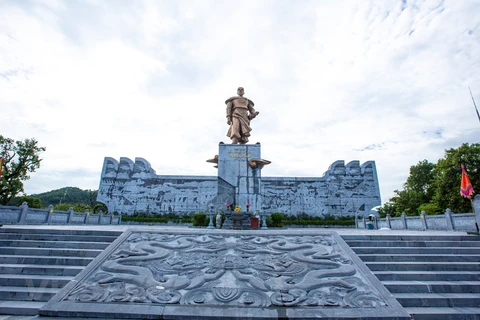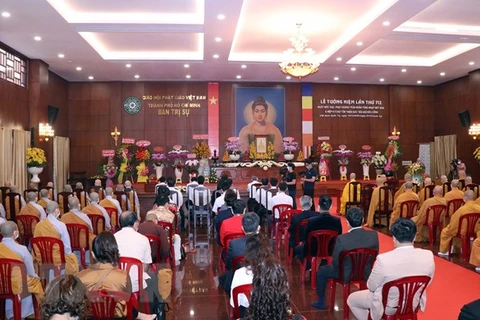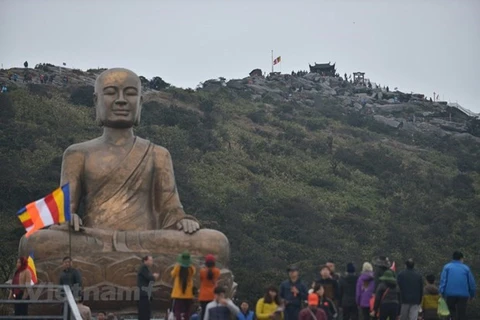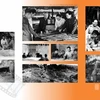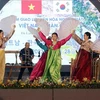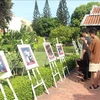 Truc Lam Yen Tu Zen Monastery, also called Lan Pagoda, was where King Tran Nhan Tong (1258 - 1308) chose to lead a religious life. The original pagoda suffered from damage over time and was re-built in 2002 (Photo: VNA)
Truc Lam Yen Tu Zen Monastery, also called Lan Pagoda, was where King Tran Nhan Tong (1258 - 1308) chose to lead a religious life. The original pagoda suffered from damage over time and was re-built in 2002 (Photo: VNA) Hanoi (VNA) – Quang Ninh, Hai Duong, and Bac Giang are making preparations to build a dossier seeking UNESCO’s recognition of the Complex of Yen Tu Monuments and Landscape, covering part of these northern provinces, as a world heritage site.
Special values
The complex is comprised of four clusters of special national historical relics: the Yen Tu historical relic and landscape area (Uong Bi city of Quang Ninh), the Tran Dynasty historical relic area (Dong Trieu town of Quang Ninh), the Tay (Western) Yen Tu relic and landscape area (Bac Giang), and the Con Son - Kiep Bac - Thanh Mai complex (Hai Duong).
A large number of relics and landscapes there, including historical relics, architectural - artistic relics, archaeological relics, and scenic landscapes, have been recognised to be of provincial or national importance.
These sites boast harmonious combination of natural landscapes and architectural structures with special value such as the pagodas of Bi Thuong, Suoi Tam, Cam Thuc, Lan, and Giai Oan, and Hon Ngoc Garden of Towers.
The complex also holds great historical significance as it is the birthplace of the Vietnamese Zen Buddhism founded by King-Monk Tran Nhan Tong (1258 - 1308).
The foundation and development of the Truc Lam Yen Tu Zen Buddhist sect in this place have left valuable scriptures and books for monks and ordinary people. The writings have become precious cultural heritages accompanying the country throughout history.
In addition, Yen Tu Mountain is also home to a large number of rare fauna and flora species that cannot be found anywhere else.
The beauty of Yen Tu lies in the magnificence of mountains, the solemnity of pagodas and towers, the poetry of landscapes, and the diversity of plants. Therefore, it used to be listed as one of the 72 “phuc dia” (lands of happiness) in the country.
Given the particularly important values of Yen Tu, the State issued Decision 15/VH-QD on March 13, 1974 to recognise the Complex of Yen Tu Monuments and Landscape as a national relic site. On September 27, 2012, the Prime Minister issued Decision 1419/QD-TTg to list this complex as a special national relic site.
Besides, Yen Tu was also recognised as the Buddhist centre of Vietnam at the third National Buddhist Congress, held in Hanoi in November 1992.
Dossier to be compiled to seek UNESCO’s recognition
In late January this year, Deputy Prime Minister Vu Duc Dam assigned the Ministry of Culture, Sports and Tourism to work with the Vietnam National UNESCO Committee to send a brief report to the UNESCO World Heritage Centre asking for the inclusion of this complex in the list of those planned to have world heritage dossiers compiled.
 A statue of King-Monk Tran Nhan Tong resembling Lord Buddha’s attainment of nirvana at Ngoa Van Pagoda on Bao Dai Mountain. Ngoa Van Pagoda was where Tran Nhan Tong and some enlightened monks of the Tran Dynasty and the Le Trung Hung (Revival Le) Dynasty led a religious life and passed away (Photo: VNA)
A statue of King-Monk Tran Nhan Tong resembling Lord Buddha’s attainment of nirvana at Ngoa Van Pagoda on Bao Dai Mountain. Ngoa Van Pagoda was where Tran Nhan Tong and some enlightened monks of the Tran Dynasty and the Le Trung Hung (Revival Le) Dynasty led a religious life and passed away (Photo: VNA) This brief report will replace the one currently posted on the website of the UNESCO World Heritage Centre.
The Deputy PM also ordered the People’s Committee of Quang Ninh to coordinate with its counterparts in Bac Giang and Hai Duong and related agencies to compile a dossier seeking the world heritage status for the Complex of Yen Tu Monuments and Landscape.
Earlier, authorities of the three provinces organised many meetings and symposiums to identify globally outstanding values of the complex.
Nguyen Thi Hanh, Vice Chairwoman of the Quang Ninh People’s Committee, said it is not easy to compile the dossier, and the three provinces are facing great pressure when performing this task.
However, they plan to complete the compilation and submit the English-language dossier to UNESCO in September 2021 and continue carrying out other steps required by UNESCO, she noted./.
